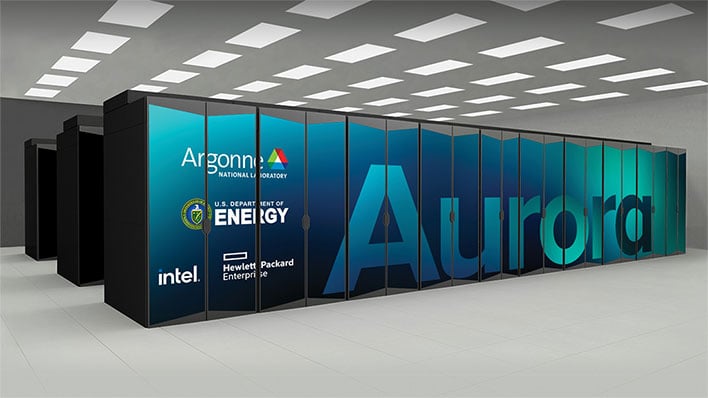Intel Ponte Vecchio, Sapphire Rapids To Deliver Massive 2 Exaflops Of Aurora Supercomputer Performance
The talk of the day might be centered on Alder Lake, but Intel made another notable announcement today, regarding the performance potential of Argonne National Laboratory's Aurora supercomputer. We already knew that Intel's next-gen Xe-HPC GPU codenamed Ponte Vecchio would help power Aurora, but revealed today, Ponte Vecchio along with Sapphire Rapids will allow the supercomputer to reach and even exceed two exaflops of peak double precision compute performance.
The combination of Intel's cutting-edge GPU and Xeon CPU architectures will enable Aurora to "
provide unprecedented capability to integrate data analytics, AI, and simulation for advanced 3D modeling." And looked at from another angle, Argonne's decision to ride shotgun with Ponte Vecchio is a big endorsement for Intel's efforts in the discrete GPU space.
Intel co-designed Aurora with Argonne and Cray, which is part of the US Department of Energy. Argonne's mission, if you will, is to be spearhead the nation's efforts to deliver future exascale computing capabilities, and it's leaning on Intel's latest hardware in that effort.
Aurora is designed to handle high-performance computing (HPC) workloads. A big part of that is crunching artificial intelligence (AI), machine learning (ML), and heavy data analytics. it will deploy next year and, with all that computing power on tap, is expected to help researchers pursue science and engineering breakthroughs. Things like clean fusion research and the such.
When Intel introduced Ponte Vecchio a couple of years ago, it talked about Aurora being the first exascale system in the US to leverage the full breadth of Intel's data-centric technology portfolio. What that translated into when Aurora arrived at Argonne was each node containing a pair of Xeon scalable processors (Sapphire Rapids), half a dozen Xe GPUs (Ponte Vecchio), a unified memory architecture across both parts, and eight fabric endpoints per node. Aurora as a whole also boasts 10 petabytes of memory and over 230 petabytes of storage.
On the CPU side, Intel says it is targeting a 30X total AI performance uplift with Sapphire Rapids, compared to the previous generation. This is achieved through both a built-in AMX engine and extensive software optimizations.
This also plays into Intel's investments in AI and ML, to make both more accessible to developers. That includes committing to open platforms as well.
"Intel’s deep investments in developer ecosystems, tools, technology, and an open platform are clearing the path forward to
scale AI everywhere. Intel’s role is to responsibly scale this technology. Intel has made AI more accessible and scalable
for developers through extensive optimizations of popular libraries and frameworks on Intel Xeon Scalable processors," Intel says.
It will be interesting to see what advancements arise out of Aurora as time goes on.


